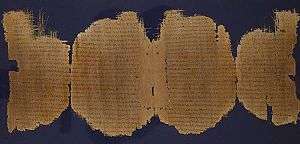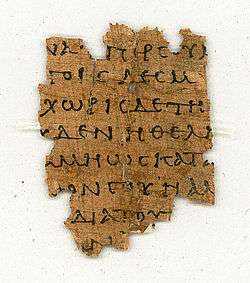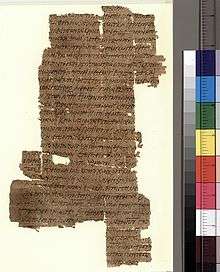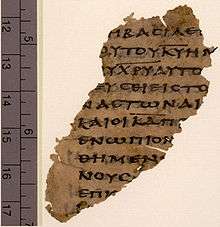Biblical manuscript
A biblical manuscript is any handwritten copy of a portion of the text of the Bible. The word Bible comes from the Greek biblia (books); manuscript comes from Latin manu (hand) and scriptum (written). The original manuscript (the original parchment the author physically wrote on) is called the "autographa." Biblical manuscripts vary in size from tiny scrolls containing individual verses of the Jewish scriptures (see Tefillin) to huge polyglot codices (multi-lingual books) containing both the Hebrew Bible (Tanakh) and the New Testament, as well as extracanonical works.
The study of biblical manuscripts is important because handwritten copies of books can contain errors. The science of textual criticism attempts to reconstruct the original text of books, especially those published prior to the invention of the printing press.
| Part of a series on the |
| Bible |
|---|
 |
|
Interpretation |
|
Perspectives |
|
|
Hebrew Bible (or Tanakh) manuscripts
.jpg)
The Aleppo Codex (c. 920 CE) and Leningrad Codex (c. 1008 CE) were the oldest Hebrew language manuscripts of the Tanakh. In 1947 the finding of the Dead Sea scrolls at Qumran pushed the manuscript history of the Tanakh back a millennium from the two earliest complete codices. Before this discovery, the earliest extant manuscripts of the Old Testament were in Greek in manuscripts such as Codex Vaticanus and Codex Sinaiticus. Out of the roughly 800 manuscripts found at Qumran, 220 are from the Tanakh. Every book of the Tanakh is represented except for the Book of Esther; however, most are fragmentary. Notably, there are two scrolls of the Book of Isaiah, one complete (1QIsa), and one around 75% complete (1QIsb). These manuscripts generally date between 150 BCE to 70 CE.[1]
Extant Tanakh manuscripts
| Version | Examples | Language | Date of Composition | Oldest Copy | ||||||
|---|---|---|---|---|---|---|---|---|---|---|
| Silver Scrolls | Paleo-Hebrew | c. 650 BCE (some few verses) | ||||||||
| Dead Sea Scrolls | Tanakh at Qumran | Hebrew, Aramaic, and Greek | c. 150 BCE – 70 CE | c. 150 BCE – 70 CE (fragments) | ||||||
| Septuagint | Codex Vaticanus, Codex Sinaiticus and other earlier papyri | Greek | 300–100 BCE | 2nd century BCE (fragments) 4th century CE (complete) | ||||||
| Peshitta | Syriac | early 5th century CE | ||||||||
| Vulgate | Codex Amiatinus | Latin | early 5th century CE early 8th century CE (complete) | |||||||
| Masoretic | Aleppo Codex, Leningrad Codex and other, incomplete MSS | Hebrew | c. 100 CE | 10th century CE (complete) | ||||||
| Samaritan Pentateuch | Samaritan Hebrew | 200–100 BCE | Oldest extant MSS, c. 11th century CE; oldest MSS available to scholars, 16th century CE | |||||||
| Targum | Aramaic | 500–1000 CE | 5th century CE | |||||||
| Coptic | Crosby-Schøyen Codex, British Library MS. Oriental 7594 | Coptic | 3rd or 4th century CE | |||||||
New Testament manuscripts
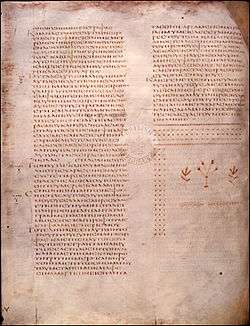
Parts of the New Testament have been preserved in more manuscripts than any other ancient work, having over 5,800 complete or fragmented Greek manuscripts, 10,000 Latin manuscripts and 9,300 manuscripts in various other ancient languages including Syriac, Slavic, Gothic, Ethiopic, Coptic and Armenian. The dates of these manuscripts range from c. 125 (the 52 papyrus, oldest copy of John fragments) to the introduction of printing in Germany in the 15th century. The vast majority of these manuscripts date after the 10th century. Although there are more manuscripts that preserve the New Testament than there are for any other ancient writing, the exact form of the text preserved in these later, numerous manuscripts may not be identical to the form of the text as it existed in antiquity. Textual scholar Bart D. Ehrman writes: "It is true, of course, that the New Testament is abundantly attested in the manuscripts produced through the ages, but most of these manuscripts are many centuries removed from the originals, and none of them perfectly accurate. They all contain mistakes - altogether many thousands of mistakes. It is not an easy task to reconstruct the original words of the New Testament...."[2] In reference to the textual evidence for the New Testament, Bruce M. Metzger wrote,
In evaluating the significance of these statistics...one should consider, by way of contrast, the number of manuscripts which preserve the text of the ancient classics. Homer's Iliad...is preserved by 457 papyri, 2 uncial manuscripts, and 188 minuscule manuscripts. Among the tragedians the witnesses to Euripides are the most abundant; his extant works are preserved in 54 papyri and 276 parchment manuscripts, almost all of the later dating from the Byzantine period...the time between the composition of the books of the New Testament and the earliest extant copies is relatively brief. Instead of the lapse of a millennium or more, as is the case of not a few classical authors, several papyrus manuscripts of portions of the New Testament are extant which were copies within a century or so after the composition of the original documents.[3][4]
Biblical scholar Gary Habermas adds, "What is usually meant is that the New Testament has far more manuscript evidence from a far earlier period than other classical works. There are just under 6000 NT manuscripts, with copies of most of the NT dating from just 100 years or so after its writing. Classical sources almost always have fewer than 20 copies each and usually date from 700-1400 years after the composition of the work. In this regard, the classics are not as well attested. While this doesn't guarantee truthfulness, it means that it is much easier to reconstruct the New Testament text. Regarding genre, the Gospels are usually taken today to be examples of Roman biographies."[5]
Every year, several New Testament manuscripts handwritten in the original Greek format are discovered. The latest substantial find was in 2008, when 47 new manuscripts were discovered in Albania; at least 17 of them unknown to Western scholars.[6] When comparing one manuscript to another, with the exception of the smallest fragments, no two copies agree completely throughout. There has been an estimate of 400,000 variations among all these manuscripts (from the 2nd to 15th century) which is more than there are words in the New Testament. This is less significant than may appear since it is a comparison across linguistic boundaries. More important estimates focus on comparing texts within languages. Those variations are considerably fewer. The vast majority of these are accidental errors made by scribes, and are easily identified as such: an omitted word, a duplicate line, a misspelling, a rearrangement of words. Some variations involve apparently intentional changes, which often make more difficult a determination of whether they were corrections from better exemplars, harmonizations between readings, or ideologically motivated.[7] Palaeography is the study of ancient writing, and textual criticism is the study of manuscripts in order to reconstruct a probable original text.
The difficulty is in where the manuscripts are coming from. Often, especially in monasteries, a manuscript cache is little more than a former manuscript recycling center where imperfect and incomplete copies of manuscripts were stored while the monastery or scriptorium decided what to do with them.[8] There were several options. The first was to simply "wash" the manuscript and reuse it. This was very common in the ancient world and even up into the Middle Ages; such reused manuscripts are called palimpsests. The most famous palimpsest is probably the Archimedes Palimpsest. If this was not done within a short period of time after the papyri was made, then washing it was less likely since the papyri might deteriorate and thus be unusable. When washing was no longer an option, the second choice was burning: since they contained the words of Christ, they were thought to have had a level of sanctity,[8] and burning them was considered more reverent than simply throwing them into a garbage pit (although that was not unheard of as in the case of Oxyrhynchus 840). The third option was simply to leave them in what has become known as a manuscript gravesite. When scholars come across manuscript caches, for example that at Saint Catherine's Monastery in the Sinai (source of the Codex Sinaiticus), or Saint Sabbas Monastery outside Bethlehem, they are not finding libraries, but storehouses of rejected texts[8] (sometimes kept in boxes or back shelves in libraries due to space constraints). These texts were unacceptable because of their scribal errors and contain corrections inside the lines[9] possibly evidence that monastery scribes were comparing them to what must have been a master text. In addition, texts thought to be complete and correct but which had deteriorated due to heavy usage or had missing folios would also be placed in these caches. Once in a cache, insects and humidity would often contribute to the continued deterioration of the documents.[8]
Complete and correctly copied texts would usually be immediately placed in use and thus usually would wear out fairly quickly, requiring repeated recopying. Further, because manuscript copying was highly costly when it required a scribe's attention for extended periods, a manuscript might only be made when commissioned, in which case the size of the parchment, script used, any illustrations (thus raising the effective cost), whether it was one book or a collection of several, etc. would be determined by the one commissioning the work. The idea of stocking extra copies would probably have been considered at best wasteful and unnecessary since the form and presentation of a manuscript were more often than not customized to the aesthetic tastes of the buyer. This is part of the reason why scholars are more likely to find incomplete, and at times conflicting, segments of manuscripts than complete and largely consistent works.[8]
Distribution of Greek manuscripts by century[10]
| New Testament manuscripts | Lectionaries | ||||
| Century | Papyri | Uncials | Minuscules | Uncials | Minuscules |
| 2nd | 2 | - | - | - | - |
| 2nd/3rd | 5 | 1 | - | - | - |
| 3rd | 28 | 2 | - | - | - |
| 3rd/4th | 8 | 2 | - | - | - |
| 4th | 14 | 14 | - | 1 | - |
| 4th/5th | 8 | 8 | - | - | - |
| 5th | 2 | 36 | - | 1 | - |
| 5th/6th | 4 | 10 | - | - | - |
| 6th | 7 | 51 | - | 3 | - |
| 6th/7th | 5 | 5 | - | 1 | - |
| 7th | 8 | 28 | - | 4 | - |
| 7th/8th | 3 | 4 | - | - | - |
| 8th | 2 | 29 | - | 22 | - |
| 8th/9th | - | 4 | - | 5 | - |
| 9th | - | 53 | 13 | 113 | 5 |
| 9th/10th | - | 1 | 4 | - | 1 |
| 10th | - | 17 | 124 | 108 | 38 |
| 10th/11th | - | 3 | 8 | 3 | 4 |
| 11th | - | 1 | 429 | 15 | 227 |
| 11th/12th | - | - | 33 | - | 13 |
| 12th | - | - | 555 | 6 | 486 |
| 12th/13th | - | - | 26 | - | 17 |
| 13th | - | - | 547 | 4 | 394 |
| 13th/14th | - | - | 28 | - | 17 |
| 14th | - | - | 511 | - | 308 |
| 14th/15th | - | - | 8 | - | 2 |
| 15th | - | - | 241 | - | 171 |
| 15th/16th | - | - | 4 | - | 2 |
| 16th | - | - | 136 | - | 194 |
Transmission
The task of copying manuscripts was generally done by scribes who were trained professionals in the arts of writing and bookmaking. Some manuscripts were also proofread, and scholars closely examining a text can sometimes find the original and corrections found in certain manuscripts. In the 6th century, a special room devoted to the practice of manuscript writing and illumination called the scriptorium came into use, typically inside medieval European monasteries. Sometimes a group of scribes would make copies at the same time as one individual read from the text.[11]
Manuscript construction
An important issue with manuscripts is preservation. The earliest New Testament manuscripts were written on papyrus, made from a reed that grew abundantly in the Nile Delta. This tradition continued as late as the 8th century.[12] Papyrus eventually becomes brittle and deteriorates with age. The dry climate of Egypt allowed some papyrus manuscripts to be partially preserved, but, with the exception of 77, no New Testament papyrus manuscript is complete; many consist only of a single fragmented page.[13] Beginning in the fourth century, parchment (also called vellum) began to be a common medium for New Testament manuscripts.[14] It wasn't until the twelfth century that paper (made from cotton or plant fibers), which was invented in first-century China, began to gain popularity in biblical manuscripts.[15]
Of the 476 non-Christian manuscripts dated to the second century, 97% of the manuscripts are in the form of scrolls; however, eight Christian manuscripts are codices. In fact, most New Testament manuscripts are codices. The adaptation of the codex form in non-Christian text did not become dominant until the fourth and fifth centuries, showing a preference for that form amongst early Christians.[16] The considerable length of some New Testament books (such as the Pauline epistles), and the New Testament itself, was not suited to the limited space available on a single scroll; in contrast a codex could be expanded to hundreds of pages.
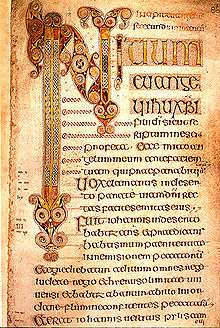
Script and other features
The handwriting found in New Testament manuscripts varies. One way of classifying handwriting is by formality: book-hand vs. cursive. More formal, literary Greek works were often written in a distinctive style of even, capital letters called book-hand. Less formal writing consisted of cursive letters which could be written quickly. Another way of dividing handwriting is between uncial script (or majuscule) and minuscule. The uncial letters were a consistent height between the baseline and the cap height, while the minuscule letters had ascenders and descenders that moved past the baseline and cap height. Generally speaking, the majuscules are earlier than the minuscules, with a dividing line roughly in the 11th century.[17]
The earliest manuscripts had negligible punctuation and breathing marks. The manuscripts also lacked word spacing, so words, sentences, and paragraphs would be a continuous string of letters (scriptio continua), often with line breaks in the middle of words. Bookmaking was an expensive endeavor, and one way to reduce the number of pages used was to save space. Another method employed was to abbreviate frequent words, such as the nomina sacra. Yet another method involved the palimpsest, a manuscript which recycled an older manuscript. Scholars using careful examination can sometimes determine what was originally written on the material of a document before it was erased to make way for a new text (for example Codex Ephraemi Rescriptus and the Syriac Sinaiticus).
The original New Testament books did not have titles, section headings, or verse and chapter divisions. These were developed over the years as "helps for readers". The Eusebian Canons were an early system of division written in the margin of many manuscripts. The Eusebian Canons are a series of tables that grouped parallel stories among the gospels. Starting in the fifth century, subject headings (κεφαλαία) were used.
Manuscripts became more ornate over the centuries, which developed into a rich illuminated manuscript tradition, including the famous Irish Gospel Books, the Book of Kells and the Book of Durrow.
Cataloging
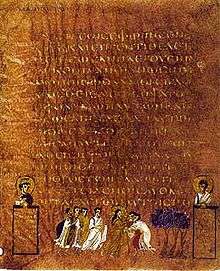
Desiderius Erasmus compiled the first printed edition of the Greek New Testament in 1516, basing his work on several manuscripts because he did not have a single complete work and because each manuscript had small errors. In the 18th century, Johann Jakob Wettstein was one of the first biblical scholars to start cataloging biblical manuscripts. He divided the manuscripts based on the writing used (uncial, minuscule) or format (lectionaries) and based on content (Gospels, Pauline letters, Acts + General epistles, and Revelation). He assigned the uncials letters and minuscules and lectionaries numbers for each grouping of content, which resulted in manuscripts being assigned the same letter or number.[18]
For manuscripts that contained the whole New Testament, such as Codex Alexandrinus (A) and Codex Ephraemi Rescriptus (C), the letters corresponded across content groupings. For significant early manuscripts such as Codex Vaticanus Graecus 1209 (B), which did not contain Revelation, the letter B was also assigned to a later 10th-century manuscript of Revelation, thus creating confusion. Constantin von Tischendorf found one of the earliest, nearly complete copies of the Bible, Codex Sinaiticus, over a century after Wettstein's cataloging system was introduced. Because he felt the manuscript was so important, Von Tischendorf assigned it the Hebrew letter aleph (א). Eventually enough uncials were found that all the letters in the Latin alphabet had been used, and scholars moved on to first the Greek alphabet, and eventually started reusing characters by adding a superscript. Confusion also existed in the minuscules, where up to seven different manuscripts could have the same number or a single manuscript of the complete New Testament could have 4 different numbers to describe the different content groupings.[19]
Von Soden
Hermann, Freiherr von Soden published a complex cataloging system for manuscripts in 1902-10.[20] He grouped the manuscripts based on content, assigning them a Greek prefix: δ for the complete New Testament, ε for the Gospels, and α for the remaining parts. This grouping was flawed because some manuscripts grouped in δ did not contain Revelation, and many manuscripts grouped in α contained either the general epistles or the Pauline epistles, but not both. After the Greek prefix, Von Soden assigned a numeral that roughly corresponded to a date (for example δ1-δ49 were from before the 10th century, δ150-δ249 for the 11th century). This system proved to be problematic when manuscripts were re-dated, or when more manuscripts were discovered than the number of spaces allocated to a certain century.[21]
Gregory–Aland
Caspar René Gregory published another cataloging system in 1908 in Die griechischen Handschriften des Neuen Testaments, which is the system still in use today. Gregory divided the manuscripts into four groupings: papyri, uncials, minuscules, and lectionaries. This division is partially arbitrary. The first grouping is based on the physical material (papyrus) used in the manuscripts. The second two divisions are based on script: uncial and minuscule. The last grouping is based on content: lectionary. Most of the papyrus manuscripts and the lectionaries before the year 1000 are written in uncial script. There is some consistency in that the majority of the papyri are very early because parchment began to replace papyrus in the 4th century (although the latest papyri dates to the 8th century). Similarly, the majority of the uncials date to before the 11th century, and the majority of the minuscules to after.[22]
Gregory assigned the papyri a prefix of P, often written in blackletter script (n), with a superscript numeral. The uncials were given a prefix of the number 0, and the established letters for the major manuscripts were retained for redundancy (e.g. Codex Claromontanus is assigned both 06 and D). The minuscules were given plain numbers, and the lectionaries were prefixed with l often written in script (ℓ). Kurt Aland continued Gregory's cataloging work through the 1950s and beyond. Because of this, the numbering system is often referred to as "Gregory-Aland numbers". The most recent manuscripts added to each grouping are 131, 0323, 2928, and ℓ 2463.[23] Due to the cataloging heritage and because some manuscripts which were initially numbered separately were discovered to be from the same codex, there is some redundancy in the list (i.e. the Magdalen papyrus has both the numbers of 64 and 67).[24]
The majority of New Testament textual criticism deals with Greek manuscripts because scholars believe the original books of the New Testament were written in Greek. The text of the New Testament is also found both translated in manuscripts of many different languages (called versions) and quoted in manuscripts of the writings of the Church Fathers. In the critical apparatus of the Novum Testamentum Graece, a series of abbreviations and prefixes designate different language versions (it for Old Latin, lowercase letters for individual Old Latin manuscripts, vg for Vulgate, lat for Latin, sys for Sinaitic Palimpsest, syc for Curetonian Gospels, syp for the Peshitta, co for Coptic, ac for Akhmimic, bo for Bohairic, sa for Sahidic, arm for Armenian, geo for Georgian, got for Gothic, aeth for Ethiopic, and slav for Old Church Slavonic).[25]
Dating the New Testament manuscripts

The New Testament books appear to have been completed within the 1st century. The original manuscripts of the New Testament books have not survived. The autographs were lost or destroyed a long time ago. What survives are copies of the original. Generally speaking, these copies were made centuries after the originals from other copies rather than from the autograph. Paleography, a science of dating manuscripts by typological analysis of their scripts, is the most precise and objective means known for determining the age of a manuscript. Script groups belong typologically to their generation; and changes can be noted with great accuracy over relatively short periods of time. Dating of manuscript material by a radiocarbon dating test requires that a small part of the material be destroyed in the process; it is less accurate than dating from paleography.[26] Both radiocarbon and paleographical dating only give a range of possible dates, and it is still debated just how narrow this range might be. Dates established by radiocarbon dating can present a range of 10 to over 100 years. Similarly, dates established by paleography can present a range of 25 to over 125 years.[27]
- Earliest extant manuscripts
The earliest manuscript of a New Testament text is a business-card-sized fragment from the Gospel of John, Rylands Library Papyrus P52, which may be as early as the first half of the 2nd century. The first complete copies of single New Testament books appear around 200, and the earliest complete copy of the New Testament, the Codex Sinaiticus dates to the 4th century.[28] The following table lists the earliest extant manuscript witnesses for the books of the New Testament.
|
Book |
Earliest Extant |
Date |
Condition |
|
1, 19, 21, 25, 37, 45, 53, 64, 67, 70, 77, 101, 103, 104[29] |
c. 150–250 (2nd–3rd century) |
Large fragments | |
|
c. 250 (3rd century) |
Large fragments | ||
|
c. 175–250 (2nd–3rd century) |
Large fragments | ||
|
c. 125–250 (2nd–3rd century) |
Large fragments | ||
|
Early 3rd century[30] |
Large fragments | ||
|
c. 175–225 (2nd–3rd century) |
Fragments | ||
|
c. 175–225 (2nd–3rd century) |
Fragments | ||
|
c. 175–225 (2nd–3rd century) |
Fragments | ||
|
c. 175–225 (2nd–3rd century) |
Fragments | ||
|
c. 175–225 (2nd–3rd century) |
Fragments | ||
|
c. 175–225 (2nd–3rd century) |
Fragments | ||
|
c. 175–225 (2nd–3rd century) |
Fragments | ||
|
c. 175–225 (2nd–3rd century) |
Fragments | ||
|
Early 3rd century |
Fragments | ||
|
c. 350 (4th century) |
Complete | ||
|
c. 350 (4th century) |
Complete | ||
|
c. 200 (late 2nd – early 3rd century) |
Fragment | ||
|
3rd century |
Fragment | ||
|
c. 175–225 (2nd–3rd century) |
Fragments | ||
|
3rd Century |
Fragments | ||
|
c. 300 (late 3rd – early 4th century) |
Fragments | ||
|
c. 300 (late 3rd – early 4th century) |
Fragments | ||
|
3rd century |
Fragment | ||
|
c. 350 (4th century) |
Complete | ||
|
c. 350 (4th century) |
Complete | ||
|
c. 300 (late 3rd – early 4th century) |
Fragments | ||
|
c. 150–250 (2nd-3rd century) |
Fragment |
Textual criticism
None of the original documents of the New Testament is extant and the existing copies differ from one another. The textual critic seeks to ascertain from the divergent copies which form of the text should be regarded as most conforming to the original.[31] The New Testament has been preserved in three major manuscript traditions: the 4th-century-CE Alexandrian text-type, the Western text-type, and the Byzantine text-type, which includes over 80% of all manuscripts, the majority comparatively very late in the tradition.
Since the mid-19th century, eclecticism, in which there is no a priori bias to a single manuscript, has been the dominant method of editing the Greek text of the New Testament (currently, the United Bible Society, 4th ed. and Nestle-Aland, 27th ed.). In textual criticism, eclecticism is the practice of examining a wide number of text witnesses and selecting the variant that seems best. The result of the process is a text with readings drawn from many witnesses. In a purely eclectic approach, no single witness is theoretically favored. Instead, the critic forms opinions about individual witnesses, relying on both external and internal evidence. Even so, the oldest manuscripts, being of the Alexandrian text-type, are the most favored, and the critical text has an Alexandrian disposition.[32] Modern translations of the New Testament are based on these copies.
Listings
- List of New Testament papyri
- List of New Testament uncials
- List of New Testament minuscules
- List of New Testament lectionaries
- List of New Testament Latin manuscripts
Gallery
-

Fragments of the Dead Sea scrolls on display at the Archeological Museum, Amman
-
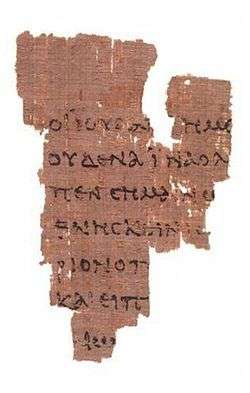
52 is the oldest known manuscript fragment of the New Testament.
-
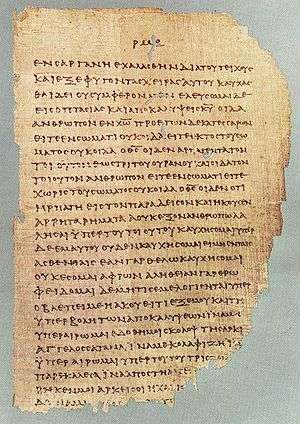
46 is the earliest (nearly) complete manuscript of the Epistles written by Paul in the new testament.
-
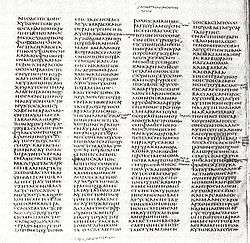
Codex Sinaiticus (c. 350) contains the oldest complete copy of the New Testament, as well as most of the Greek Old Testament, known as the Septuagint
-
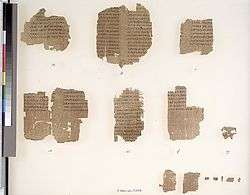
P. Chester Beatty VI showing portions of Deuteronomy
-
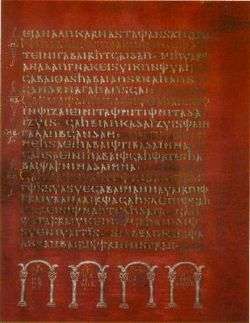
The first page of the Gothic language Codex Argenteus
-
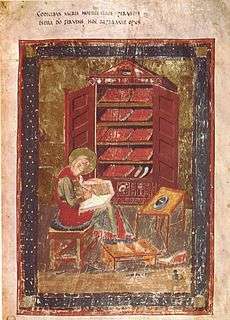
folio 5r of the Codex Amiatinus, manuscript of Vulgate
See also
- Dating the Bible
- Biblical criticism
- Textual criticism
- Categories of New Testament manuscripts
- List of major textual variants in the New Testament
- Higher Criticism
- Manuscript culture
- Nag Hammadi library
- Fifty Bibles of Constantine
- List of Hebrew Bible manuscripts
- List of illuminated manuscripts
Notes
- ↑ F. F. Bruce. "The Last Thirty Years". Story of the Bible. ed. Frederic G. Kenyon Retrieved June 19, 2007
- ↑ The New Testament: An Historical Introduction To The Early Christian Writings, Bart Ehrman p. 449
- ↑ The Text Of The New Testament: Its Transmission, Corruption & Restoration, 1992, Third Enlarged Edition, Bruce Metzger, p. 33-35
- ↑ As a footnote to his comments, Metzger also said, "Lest, however, the wrong impression be conveyed from the statistics given above regarding the total number of Greek manuscripts of the New Testament, it should be pointed out that most of the papyri are relatively fragmentary and that only about fifty manuscripts (of which the Codex Sinaiticus is the only Uncial manuscript) contain the entire New Testament." The Text Of The New Testament: Its Transmission, Corruption & Restoration, 1992, Third Enlarged Edition, Bruce Metzger, p. 34
- ↑ [Quoted from http://www.garyhabermas.com/qa/qa_index.htm]
- ↑ Michelle A Vu, "NT scholar on discovery of giant trove of Bible manuscripts," Christianity Today, April 21, 2008
- ↑ Ehrman 2004, pp.480f
- 1 2 3 4 5 Ehrman 2005
- ↑ http://www.codexsinaiticus.org/en/
- ↑ Aland, p 81
- ↑ "Seid". Retrieved 4 October 2014.
- ↑ Metzger 2005, pp.3f
- ↑ "Waltz". Retrieved 4 October 2014.
- ↑ Metzger 2005, pp.3-10
- ↑ Aland 1995, p. 77
- ↑ "Seid". Retrieved 4 October 2014.
- ↑ Metzger 2005, pp. 17-18, 20
- ↑ Aland 1995, p. 72
- ↑ Aland 1995, pp. 72-73
- ↑ Hermann von Soden, Die Schriften des Neuen Testaments, in ihrer ältesten erreichbaren Textgestalt hergestellt auf Grund ihrer Textgeschichte 4 vols., Berlin: Glaue, 1902-1910.
- ↑ Aland 1995, pp. 40-41
- ↑ Aland 1995, pp. 73-77
- ↑ New Testament Virtual Manuscript Room at the University of Münster website
- ↑ Aland 1995, pp. 73f
- ↑ NA27 1996, pp. 64*-76*
- ↑ "Britannica Online: Types of manuscript errors". Retrieved 4 October 2014.
- ↑ Egypt on the Pentateuch's Ideological Map By F. V. Greifenhagen
- ↑ Ehrman 2004, pp. 479-480
- 1 2 Willker, Wieland (17 April 2008). "Complete List of Greek NT Papyri".
- ↑ Philip W. Comfort and David P. Barrett. The Text of the Earliest New Testament Greek Manuscripts. Wheaton, Illinois: Tyndale House Publishers Incorporated, 2001, p. 65.
- ↑ Bruce M. Metzger, The Text of the New Testament: Its Transmission, Corruption, and Restoration.
- ↑ Aland, B. 1994: 138
References
- Aland, Kurt; Barbara Aland (1995). The Text of The New Testament: An Introduction to the Critical Editions and to the Theory and Practice of Modern Textual Criticism. Translated by Erroll F. Rhodes (2nd ed.). Grand Rapids, MI: Wm. B. Eerdmans Publishing Company. pp. 40f, 72f. ISBN 0-8028-4098-1.
- Ehrman, Bart D. (2004). The New Testament: A Historical Introduction to the Early Christian Writings. New York: Oxford. pp. 480f. ISBN 0-19-515462-2.
- Metzger, Bruce M. The Text of the New Testament: Its Transmission, Corruption and Restoration, Oxford University Press, 2005. ISBN 0-19-516667-1
- Nestle-Aland Novum Testamentum Graece rv. 27 (2006) Hendrickson Publishers, ISBN 1-59856-172-3
- Seid, Timothy W. "Interpreting Ancient Manuscripts". Interpreting Ancient Manuscripts Web - Earlham School of Religion. Retrieved 2007-06-19.
- Waltz, Robert. "An Introduction to New Testament Textual Criticism". A Site Inspired By: The Encyclopedia of New Testament Textual Criticism. Archived from the original on 18 June 2007. Retrieved 2007-06-19.
- Wilson, Robert Dick. (1929) 'The Textual Criticism of the Old Testament', The Princeton Theological Review 27: pp. 40f.
External links
| Wikimedia Commons has media related to Bible manuscripts. |
| Look up manuscript in Wiktionary, the free dictionary. |
- Michael D. Marlowe's Bible Research site
- Micheal W. Palmer's Greek-Language.com Manuscripts page
- TextCrit.com: Eusebian Canon in Codex A
- Biblical Manuscripts Project
- Fragment of Psalms at the Heidelberger Papyrus-Sammlung
-
 Herbermann, Charles, ed. (1913). "Manuscripts of the Bible". Catholic Encyclopedia. New York: Robert Appleton Company.
Herbermann, Charles, ed. (1913). "Manuscripts of the Bible". Catholic Encyclopedia. New York: Robert Appleton Company. - Contantinus Siamakis, Oldest Manuscript of the Bible
